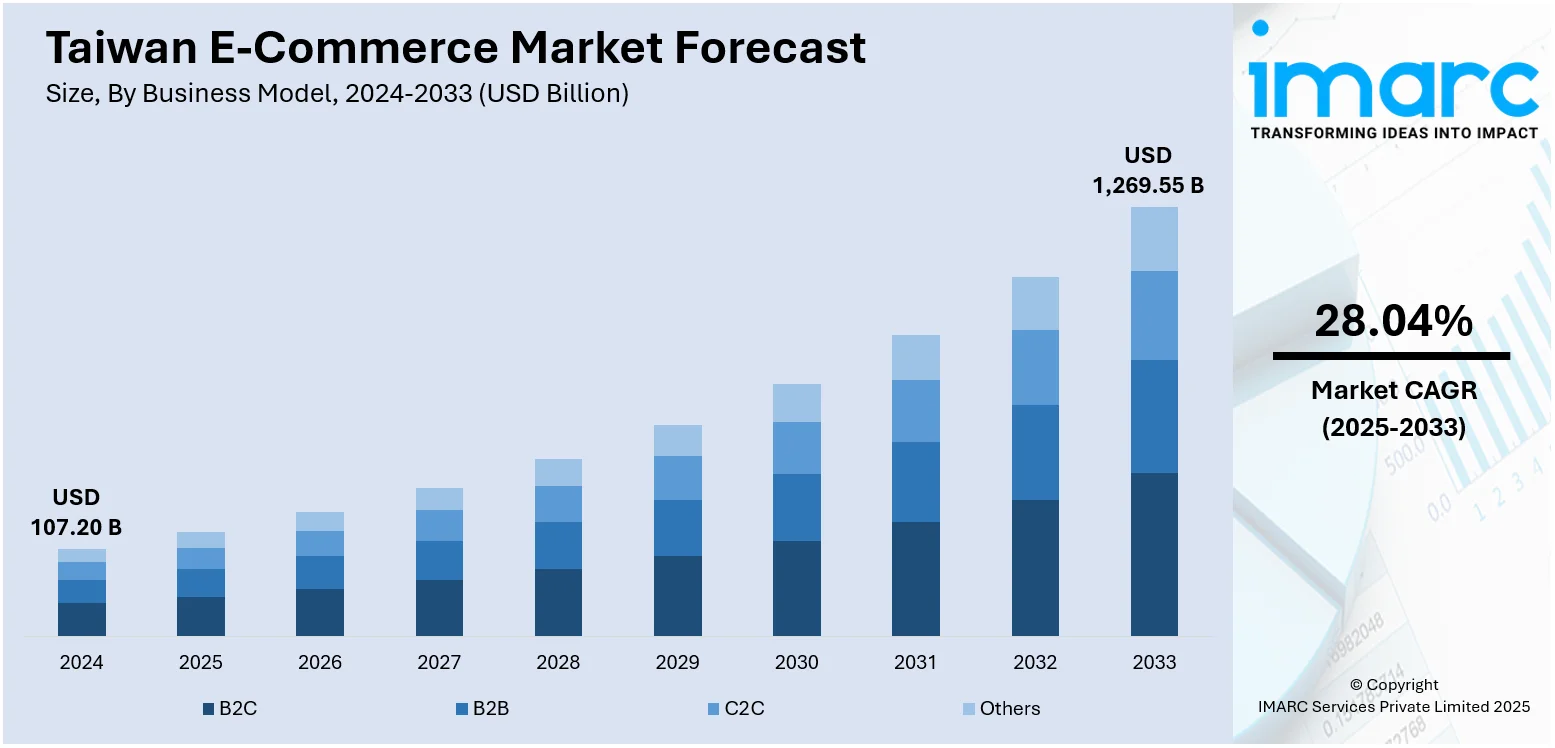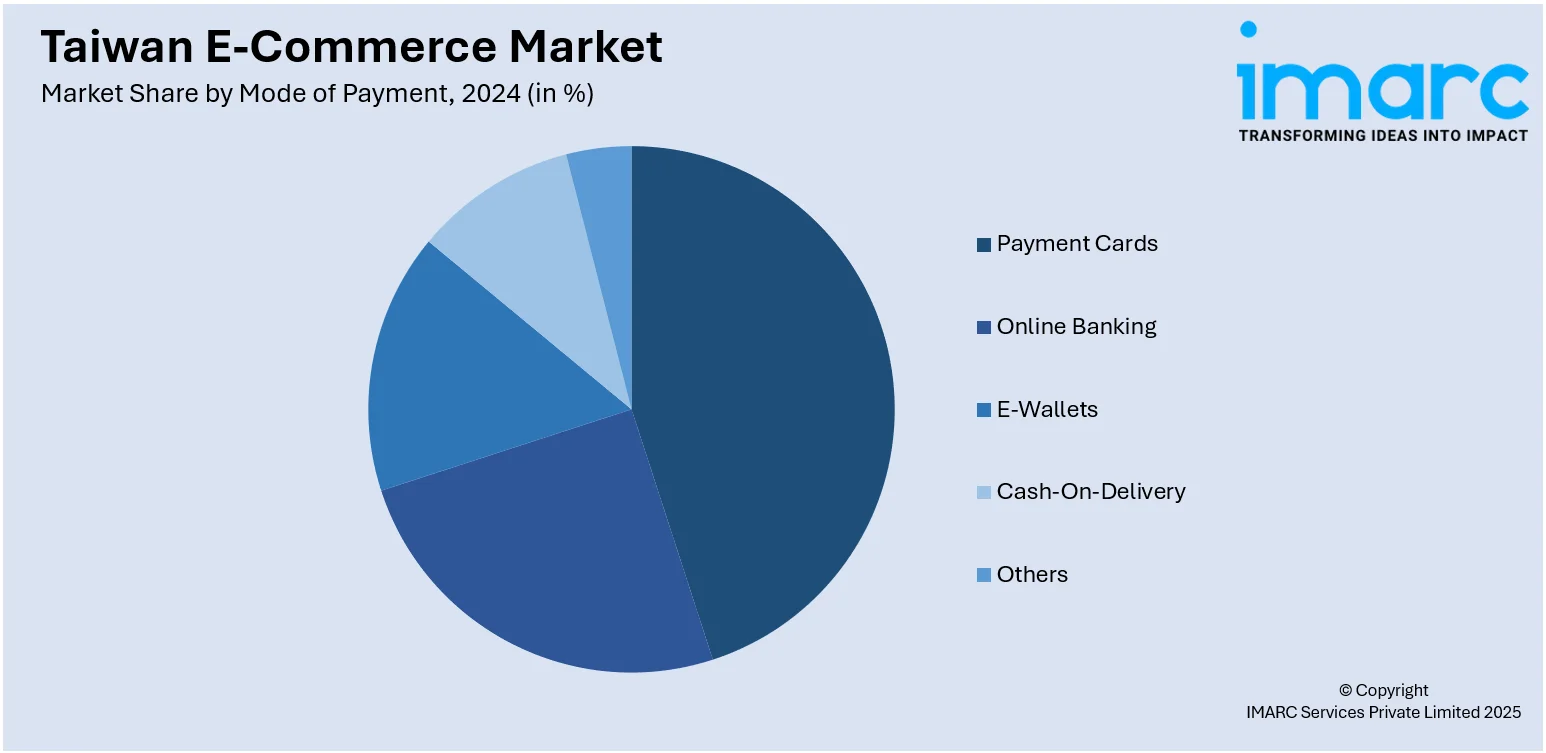
Taiwan E-Commerce Market Size, Share, Trends and Forecast by Business Model, Mode of Payment, Service Type, Product Type, and Region, 2025-2033
Taiwan E-Commerce Market Overview:
The Taiwan e-commerce market size reached USD 107.20 Billion in 2024. Looking forward, IMARC Group expects the market to reach USD 1,269.55 Billion by 2033, exhibiting a growth rate (CAGR) of 28.04% during 2025-2033. Sustainability is a crucial element driving the e-commerce market, with people seeking eco-friendly products. Brands are adopting sustainable practices to meet this demand. Additionally, the government support for e-commerce growth through digital literacy, tax incentives, and infrastructure improvements is creating a favorable environment for online businesses and individuals and contributing to the expansion of the Taiwan e-commerce market share.
|
Report Attribute
|
Key Statistics
|
|---|---|
|
Base Year
|
2024 |
|
Forecast Years
|
2025-2033
|
|
Historical Years
|
2019-2024
|
| Market Size in 2024 | USD 107.20 Billion |
| Market Forecast in 2033 | USD 1,269.55 Billion |
| Market Growth Rate 2025-2033 | 28.04% |
Taiwan E-Commerce Market Trends:
Growing Demand for Eco-Friendly and Sustainable Products
Sustainability is becoming a driving force in Taiwan’s e-commerce market as individuals increasingly seek eco-friendly and ethically produced products. In response, brands and online retailers are incorporating sustainability into their offerings, ranging from using environmentally conscious materials and packaging to adopting sustainable production processes. This growing awareness about environmental impact is leading to a rise in the demand for sustainable products, with buyers actively seeking items that align with their values. The shift toward sustainability is not only benefiting sectors like fashion and beauty but also creating new opportunities for businesses to differentiate themselves by offering products that prioritize ethical and eco-friendly practices. For example, in 2024, Rakuten Rakuma launched a second-hand luxury fashion collection in Taiwan through a partnership with Bibian and the FamilyMart app. This collaboration allowed individuals to easily purchase Japanese second-hand goods in a single payment process, tapping into Taiwan's rising demand for reused fashion, particularly among women aged 30–40. Such initiatives highlight how Taiwanese e-commerce businesses are responding to client demand for more sustainable and circular shopping options. This trend is rapidly transforming the market, as companies recognize that sustainability is not just a user preference but a key factor for long-term business success, allowing them to build brand loyalty and appeal to a growing environmentally-conscious demographic.

To get more information on this market, Request Sample
Government Support and Digital Economy Initiatives
The governing authority is plating a significant role in supporting the Taiwan e-commerce market growth through a range of initiatives designed to strengthen the digital economy. Programs that promote digital literacy, offer tax incentives to e-commerce businesses, and improve e-payment systems are creating the foundation for online enterprises to thrive. Moreover, the government’s efforts to modernize infrastructure and expand internet access, particularly in rural areas, are crucial for increasing e-commerce activity across the country. These measures are making it easier for both large and small businesses to access the resources necessary for establishing a digital presence and attracting a wider online user base. A key example of this proactive approach can be seen in 2025, when Taiwan's Ministry of Digital Affairs (MODA) required platforms like Line and TikTok to publish anti-fraud transparency reports by the end of the year. This initiative came from the Fraud Crime Hazard Prevention Act, which mandates sponsors to verify and implement fraud prevention plans. The MODA’s involvement also addressed the legal status of TikTok and the ownership concerns surrounding platforms like Shopee, ensuring that the e-commerce space operates with transparency and legal clarity. These governmental actions not only ensure the safety of users but also create an environment conducive to sustainable e-commerce growth, reinforcing Taiwan's position as a leader in the digital economy.
Taiwan E-Commerce Market Segmentation:
IMARC Group provides an analysis of the key trends in each segment of the market, along with forecasts at the country and regional levels for 2025-2033. Our report has categorized the market based on business model, mode of payment, service type, and product type.
Business Model Insights:
- B2C
- B2B
- C2C
- Others
The report has provided a detailed breakup and analysis of the market based on the business model. This includes B2C, B2B, C2C, and others.
Mode of Payment Insights:

- Payment Cards
- Online Banking
- E-Wallets
- Cash-On-Delivery
- Others
A detailed breakup and analysis of the market based on the mode of payment have also been provided in the report. This includes payment cards, online banking, e-wallets, cash-on-delivery, and others.
Service Type Insights:
- Financial
- Digital Content
- Travel and Leisure
- E-Tailing
- Others
The report has provided a detailed breakup and analysis of the market based on the service type. This includes financial, digital content, travel and leisure, e-tailing, and others.
Product Type Insights:
- Groceries
- Clothing and Accessories
- Mobiles and Electronics
- Health and Personal Care
- Others
A detailed breakup and analysis of the market based on the product type have also been provided in the report. This includes groceries, clothing and accessories, mobiles and electronics, health and personal care, and others.
Regional Insights:
- Northern Taiwan
- Central Taiwan
- Southern Taiwan
- Eastern Taiwan
The report has also provided a comprehensive analysis of all the major regional markets, which include Northern Taiwan, Central Taiwan, Southern Taiwan, and Eastern Taiwan.
Competitive Landscape:
The market research report has also provided a comprehensive analysis of the competitive landscape. Competitive analysis such as market structure, key player positioning, top winning strategies, competitive dashboard, and company evaluation quadrant has been covered in the report. Also, detailed profiles of all major companies have been provided.
Taiwan E-Commerce Market News:
- In January 2025, JCB and Taiwan Rakuten Card launched the new JCB Panda Card, offering up to 3% cashback in Taiwan via Line Pay and JKO Pay. The card also provides 1.5% cashback globally and 3.5% in Japan, Korea, and Thailand. This marks an expansion of Rakuten’s e-commerce-linked financial services in Taiwan.
- In October 2024, Mercari announced a partnership with 7-ELEVEN Taiwan (President Chain Store) to enable pickup of cross-border purchases at over 7,000 convenience stores. This move aimed to enhance user convenience in Taiwan, where most e-commerce deliveries are picked up in stores.
Taiwan E-Commerce Market Report Coverage:
| Report Features | Details |
|---|---|
| Base Year of the Analysis | 2024 |
| Historical Period | 2019-2024 |
| Forecast Period | 2025-2033 |
| Units | Billion USD |
| Scope of the Report |
Exploration of Historical Trends and Market Outlook, Industry Catalysts and Challenges, Segment-Wise Historical and Future Market Assessment:
|
| Business Models Covered | B2C, B2B, C2C, Others |
| Mode of Payments Covered | Payment Cards, Online Banking, E-Wallets, Cash-On-Delivery, Others |
| Service Types Covered | Financial, Digital Content, Travel and Leisure, E-Tailing, Others |
| Product Types Covered | Groceries, Clothing and Accessories, Mobiles and Electronics, Health and Personal Care, Others |
| Regions Covered | Northern Taiwan, Central Taiwan, Southern Taiwan, Eastern Taiwan |
| Customization Scope | 10% Free Customization |
| Post-Sale Analyst Support | 10-12 Weeks |
| Delivery Format | PDF and Excel through Email (We can also provide the editable version of the report in PPT/Word format on special request) |
Key Questions Answered in This Report:
- How has the Taiwan e-commerce market performed so far and how will it perform in the coming years?
- What is the breakup of the Taiwan e-commerce market on the basis of business model?
- What is the breakup of the Taiwan e-commerce market on the basis of mode of payment?
- What is the breakup of the Taiwan e-commerce market on the basis of service type?
- What is the breakup of the Taiwan e-commerce market on the basis of product type?
- What is the breakup of the Taiwan e-commerce market on the basis of region?
- What are the various stages in the value chain of the Taiwan e-commerce market?
- What are the key driving factors and challenges in the Taiwan e-commerce market?
- What is the structure of the Taiwan e-commerce market and who are the key players?
- What is the degree of competition in the Taiwan e-commerce market?
Key Benefits for Stakeholders:
- IMARC’s industry report offers a comprehensive quantitative analysis of various market segments, historical and current market trends, market forecasts, and dynamics of the Taiwan e-commerce market from 2019-2033.
- The research report provides the latest information on the market drivers, challenges, and opportunities in the Taiwan e-commerce market.
- Porter's five forces analysis assist stakeholders in assessing the impact of new entrants, competitive rivalry, supplier power, buyer power, and the threat of substitution. It helps stakeholders to analyze the level of competition within the Taiwan e-commerce industry and its attractiveness.
- Competitive landscape allows stakeholders to understand their competitive environment and provides an insight into the current positions of key players in the market.
Need more help?
- Speak to our experienced analysts for insights on the current market scenarios.
- Include additional segments and countries to customize the report as per your requirement.
- Gain an unparalleled competitive advantage in your domain by understanding how to utilize the report and positively impacting your operations and revenue.
- For further assistance, please connect with our analysts.
 Request Customization
Request Customization
 Speak to an Analyst
Speak to an Analyst
 Request Brochure
Request Brochure
 Inquire Before Buying
Inquire Before Buying




.webp)




.webp)












